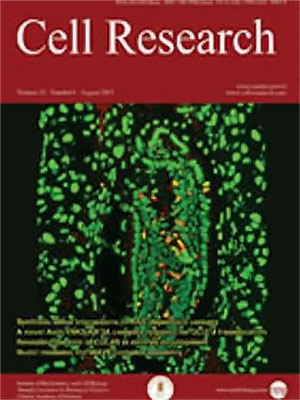
Volume 12, No 5-6, Dec 2002
ISSN: 1001-0602
EISSN: 1748-7838 2018
impact factor 17.848*
(Clarivate Analytics, 2019)
Volume 12 Issue 5-6, December 2002: 411-416
COMMENTARY
The interaction between the human
Shu Bing ZHANG, Ruo Lan QIAN*
State Key Laboratory of Molecular Biology, Institute of Biochemistry and Cell Biology, Shanghai Institutes for Biological Sciences, Chinese Academy of Sciences, 320 Yueyang Road, Shanghai 200031, China
Correspondence: Ruo Lan QIAN(qianlab@sunm.shcnc.ac.cn )
Our previous study showed that hydroxyurea (Hu) could induce HEL cells to express human
b-globin gene. However the molecular mechanisms by which the expression of
b-globin gene is activated and regulated are poorly understood. Here we show that the binding patterns between the core DNA sequences (HS2 core sequence -10681
~ -10971 bp , HS3 core sequence -14991
~ -14716 bp and HS4 core sequence -18586
~ -18306 bp) of DNase I hypersensitive sites in the human
b-globin LCR and nuclear matrix proteins isolated from Hu induced and uninduced HEL cells are quite different. Results demonstrated that nuclear matrix proteins might play important roles in regulating the expression of human
b-like globin genes through their interaction with HSs (HS2,HS3 and HS4 core sequences) in the LCR. Moreover, the results obtained from the
in vitro DNA-matrix binding assay showed that the core DNA sequences of DNase I hypersensitive sites (HS2, HS3 and HS4) were unable to bind to the nuclear matrix isolated from uninduced HEL cells; in addition, HS2 core DNA sequence was capable of binding to the nuclear matrix prepared from Hu-induced HEL cells, while both HS3 and HS4 core DNA sequences could not do so. Results indicated that the HS2 core DNA sequence may be a functional MAR (matrix attachment region). We suggest that the HS2 core DNA sequence binding to the nuclear matrix in Hu-induced HEL cells may open the structure of chromatin to make the LCR accessible to the promoter of
b-globin gene and to promote its transcription.
FULL TEXT | PDF
Browse 2183


